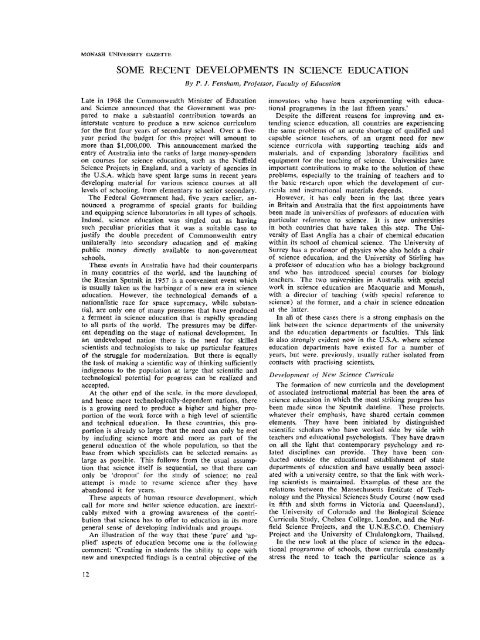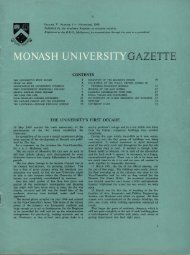Volume 6 Number 1 - Adm.monash.edu.au - Monash University
Volume 6 Number 1 - Adm.monash.edu.au - Monash University
Volume 6 Number 1 - Adm.monash.edu.au - Monash University
You also want an ePaper? Increase the reach of your titles
YUMPU automatically turns print PDFs into web optimized ePapers that Google loves.
MONASH UNIVERSITY GAZETTESOME RECENT DEVELOPMENTS IN SCIENCE EDUCATIONBy P. J. Fensham, Professor, Faculty of EducationLate in 1968 the Commonwealth Minister of Educationand Science announced that the Government was preparedto make a substantial contribution towards aninterstate venture to produce a new science curriculumfor the first four years of secondary schooL Over a fiveyearperiod the budget for this project will amount tomore than $1,000,000. This announcement marked theentry of Australia into the ranks of large money-spenderson courses for science <strong>edu</strong>cation, such as the NuffieldScience Projects in England, and a variety of agencies inthe U.S.A. which have spent large sums in recent yearsdeveloping material for various science courses at alllevels of schooling, from elementary to senior secondary.The Federal Government had, five years earlier, announceda programme of special grants for buildingand equipping science laboratories in all types of schools.Indeed. science <strong>edu</strong>cation was singled out as havingsuch peculiar priorities that it was a suitable case tojustify the double precedent of Commonwealth entryunilaterally into secondary <strong>edu</strong>cation and of makingpublic money directly available to non-governmentschooTs.These events in Australia have had their counterpartsin many countries of the world. and the l<strong>au</strong>nching ofthe Russian Sputnik in 1957 is a convenient event whichis usually taken as the harbinger of a new era in science<strong>edu</strong>cation. However, the technological demands of anationalistic race for space supremacy, while substantial,are only one of many pressures that have produceda ferment in science <strong>edu</strong>cation that is rapidly spreadingto aU parts of the world. The pressures may be differentdepending on the stage of national development. Inan undeveloped nation there is the need for skilledscientists and technologists to take up particular featuresof the struggle for modernization. But there is equallythe task of making a scientific way of thinking sufficientlyindigenous to the population at large that scientific andtechnological potential for progress can be realized andaccepted.At the other end of the scale. in the more developed,and hence more technologically-dependent nations, thereis a growing need to produce a higher and higher proportionof the work force with a high level of scientificand technical <strong>edu</strong>cation. In these countries, this proportionis already so large that the need can only be metby including science more and more as part of thegeneral <strong>edu</strong>cation of the whole population, so that thebase from which specialists can be selected remains aslarge as possible. This follows from the usual assumptionthat science itself is sequential, so that there canonly be 'dropout' for the study of science; no realattempt is made to resume science after they haveabandoned it for years.These aspects of human resource development, whichcall for more and better science <strong>edu</strong>cation. are inextricablymixed with a growing awareness of the contributionthat science has to offer to <strong>edu</strong>cation in its moregeneral sense of developing individuals and groups.An illustration of the way that these 'pure' and 'applied'aspects of <strong>edu</strong>cation become one is the followingcomment: 'Creating in students the ability to cope withnew and unexpected findings is a central objective of theinnovators who have been experimenting with <strong>edu</strong>cationalprogrammes in the last fifteen years.'Despite the different reasons for improving and extendingscience <strong>edu</strong>cation, all countries are experiencingthe same problems of an acute shortage of qualified andcapable science teachers, of an urgent need for newscience curricula with supporting teaching aids andmaterials. and of expanding laboratory facilities andequipment for the teaching of science. Universities haveimportant contributions to make to the solution of theseproblems, especially to the training of teachers and tothe basic research upon which the development of curriculaand instructional materials depends.However, it has only been in the last three yearsin Britain and Australia that the first appointments havebeen made in universities of professors of <strong>edu</strong>cation withparticular reference to science. It is new universitiesin both countries that have taken this step. The <strong>University</strong>of East Anglia has a chair of chemical <strong>edu</strong>cationwithin its school of chemical science. The <strong>University</strong> ofSurrey has a professor of physics who also holds a chairof science <strong>edu</strong>cation, and the <strong>University</strong> of Stirling hasa professor of <strong>edu</strong>cation who has a biology backgroundand who has introduced special courses for biologyteachers. The two universities in Australia with specialwork in science <strong>edu</strong>cation are Macquarie and <strong>Monash</strong>,with a director of teaching (with special reference toscience) at the former, and a chair in science <strong>edu</strong>cationat the latter.In all of these cases there is a strong emphasis on thelink between the science departments of the universityand the <strong>edu</strong>cation departments or faculties. This linkis also strongly evident now in the U.S.A. where science<strong>edu</strong>cation departments have existed for a number ofyears, but were. previously, usually rather isolated fromcontacts with practising scientists.Development of New Science CurriculaThe formation of new curricula and the developmentof associated instructional material has been the area ofscience <strong>edu</strong>cation in which the most striking progress hasbeen made since the Sputnik dateline. These projects.whatever their emphasis, have shared certain commonclements. They have been initiated by distinguishedscientific scholars who have worked side by side withteachers and <strong>edu</strong>cational psychologists. They have drawnon all the light that contemporary psychology and relateddisciplines can provide. They have been conductedoutside the <strong>edu</strong>cational establishment of statedepartments of <strong>edu</strong>cation and have usually been associatedwith a university centre, so that the link with workingscientists is maintained. Examples of these are therelations between the Massechusetts Institute of Technologyand the Physical Sciences Study Course (now usedin fifth and sixth forms in Victoria and Queensland),the <strong>University</strong> of Colorado and the Biological ScienceCurricula Study, Chelsea College. London, and the NuffieldScience Projects, and the U.N.RS.C.O. ChemistryProject and the <strong>University</strong> of Chulalongkorn, Thailand.In the new look at the place of science in the <strong>edu</strong>cationalprogramme of schools, these curricula constantlystress the need to teach the particular science as a12
















